Choosing the right door feels overwhelming. Pick the wrong one, and you could waste space, ruin your design, and go over budget. Let’s make this simple for you.
The main difference is the opening mechanism. Hanging doors, or hinged doors, swing open and require floor clearance. Sliding doors glide horizontally on a track, saving space by moving parallel to the wall, making them ideal for tight areas.
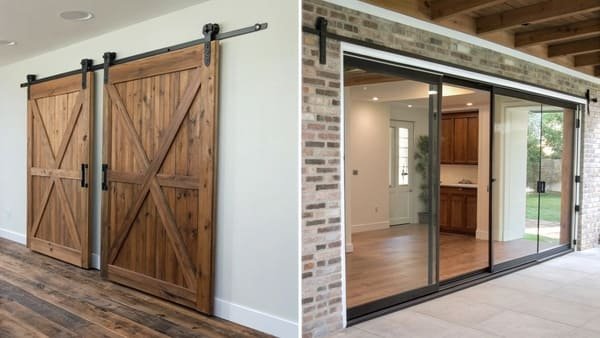
As someone who has spent years manufacturing door hardware, I see people grapple with this choice every day. On the surface, it seems simple, but the right door can completely change the feel and function of a room. It’s not just about looks; it’s about flow, space, and practicality. You need to think about who is using the space and what their priorities are, whether it’s for a residential project or a large commercial build. Let’s dive deeper into the specific questions I get all the time from purchasers like you to help you make the best decision for your inventory or project.
Are sliding doors better than hinged doors?
You need to decide which door is truly "better" for your project. Choosing based on looks alone can cause functional problems down the road. Let’s compare them on key factors.
Neither is universally "better." Sliding doors excel at saving space and creating wide, seamless openings, perfect for modern aesthetics. Hinged doors are superior for insulation, soundproofing, and security due to their tighter seal, making them a more traditional and practical choice for private rooms.
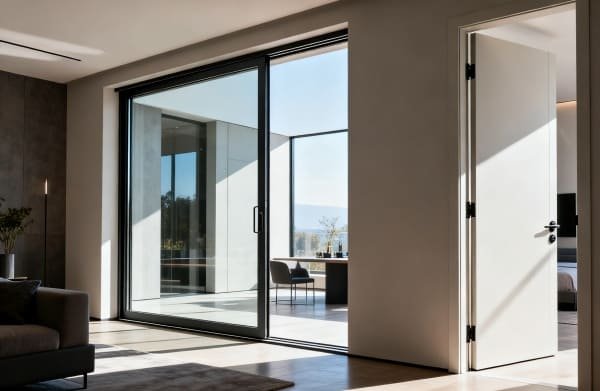
When I talk to experienced buyers like Jennifer, the conversation isn’t about which door is better overall, but which is better for a specific application. The decision depends entirely on balancing aesthetics, functionality, and the constraints of the space. For example, a developer building luxury condos might prefer the clean, open look of our Partition Room Sliding Door Rollers System for living areas. On the other hand, a contractor for a housing development will almost always spec standard hinged doors for bedrooms and bathrooms because of privacy and cost-effectiveness. It’s about matching the product to the purpose.
Key Comparison Points
| Feature | Sliding Doors | Hinged Doors (Hanging Doors) |
|---|---|---|
| Space Usage1 | Excellent. No swing space required. | Poor. Requires clear floor space to swing open. |
| Aesthetics | Modern, minimalist, clean lines. | Traditional, classic, versatile. |
| Seal & Insulation2 | Generally weaker seal. | Tighter seal, better for insulation & soundproofing. |
| Installation | Can be more complex, especially for pocket doors. | Generally simpler and faster to install. |
What is the disadvantage of a sliding door?
Sliding doors look like the perfect, space-saving solution. But hidden problems can cause maintenance headaches and performance issues if you don’t plan for them. Let’s review the downsides.
The main disadvantages are a weaker seal, leading to poor sound and thermal insulation. The tracks can also gather dirt and debris, which requires cleaning to ensure smooth operation. Repairs, especially for in-wall pocket doors, can also be complex and costly.
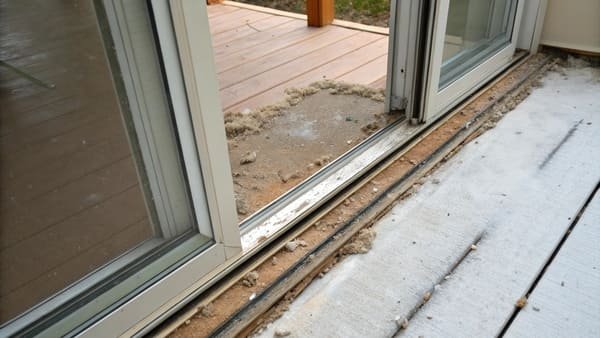
Over the years, our factory has worked hard to solve these common issues. While a perfect seal is hard to achieve, we’ve found that using high-quality brush strips along the edges can drastically reduce drafts and noise. The biggest complaint I hear is about jerky or stuck doors. This almost always comes down to cheap hardware. That’s why we focus on top-quality systems. A well-made roller, like our wooden door slow lifting wheel, provides a smooth, quiet glide for years. Investing in good hardware from the start prevents the most common frustrations and maintenance calls later on.
Common Sliding Door Problems
- Poor Sealing3: Gaps around the door can lead to drafts, heat loss, and poor soundproofing compared to the tight seal of a hinged door. This makes them less ideal for exterior walls or rooms needing high privacy, like a bedroom or office.
- Track Maintenance4: The bottom track can act as a trough for dust, pet hair, and dirt. If not cleaned regularly, this debris can obstruct the rollers and make the door difficult to open and close smoothly.
- Difficult Repairs: If a roller fails or the track gets damaged on a pocket door that slides into the wall, the repair is a major job. You often have to open up the entire wall to access the mechanism, which is far more labor-intensive than simply replacing a hinge.
Which is better, sliding or normal doors?
You know the basic differences, but now you need to pick a door for a specific room. Choosing the wrong type can be a disaster. Here is a simple guide to help.
Choose sliding doors for closets, pantries, and large patio openings where saving floor space is the priority. Use normal (hinged) doors for bedrooms, bathrooms, and main entrances where a tight seal for privacy, security, and insulation is most important.
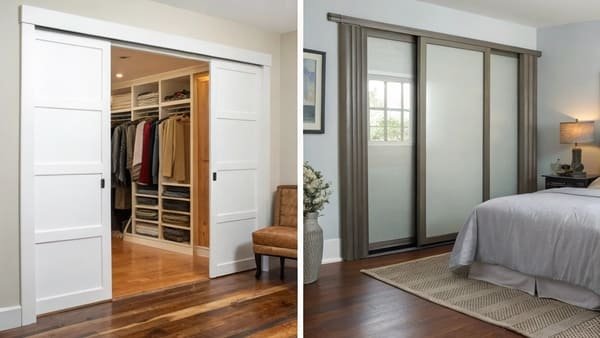
When I advise my B2B clients, I always tell them to think in terms of room function. A furniture factory purchasing manager, for instance, will almost exclusively be interested in our Wardrobe Sliding Wheels System or Cabinet Sliding Door Roller System. Their goal is to maximize storage access without a door swinging out into the room. Conversely, a door factory purchaser needs a reliable source for standard hinges for 90% of their interior and exterior doors. The key is to offer your customers the right solution for the right space. Having a good mix of both high-quality sliding hardware and traditional hinges in your inventory means you can meet any project demand.
Room-by-Room Door Guide
| Room Type | Recommended Door | Why It’s Better |
|---|---|---|
| Bedroom / Bathroom | Normal (Hinged)5 | Provides a better seal for sound privacy and can be locked securely. |
| Closet / Wardrobe | Sliding6 | Saves valuable floor space in bedrooms and allows for wider access. |
| Pantry | Sliding6 | Makes it easy to see and access contents without a door blocking a narrow hallway. |
| Patio / Deck | Sliding6 (Glass) | Creates a large opening, connects indoor/outdoor spaces, and doesn’t block the view. |
Are sliding doors cheaper than hinged doors?
Your budget is a primary concern for any project. You might assume one door type is always cheaper, but hidden costs can emerge. Let’s break down the real cost differences.
Typically, a standard-sized, basic hinged door is cheaper to buy and install than a basic sliding door. However, costs diverge quickly. Custom sizes, heavy materials, and high-quality hardware can make sliding doors, especially pocket doors, much more expensive.
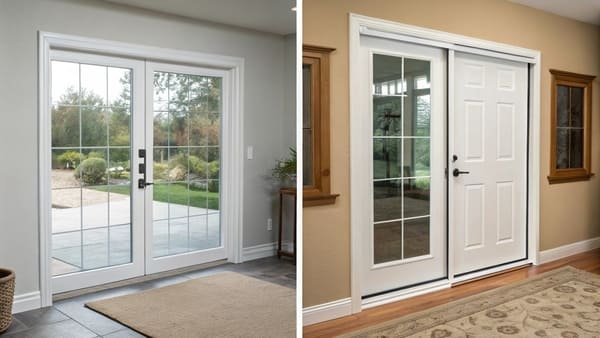
As a manufacturer, I see the whole cost picture. While a simple hollow-core hinged door is the cheapest option, the price goes up with solid wood and better hardware. For sliding doors, the door panel itself is just one part. The hardware system is critical. A cheap roller system might save money upfront but will fail quickly, leading to costly call-backs for a contractor. This is why we focus on high cost performance. We provide B2B clients with durable, reliable hardware like our heavy lifting wheel for oversized doors at a factory-direct price. This helps them deliver a high-quality finished product that lasts, protecting their reputation and their bottom line. The true cost isn’t just the purchase price; it’s the long-term value and reliability.
Cost Factor Breakdown
- Door Cost7: A basic, hollow-core hinged door slab is one of the most affordable options available. Sliding door panels, especially large glass ones, are almost always more expensive.
- Hardware Cost: A set of two or three simple hinges is very inexpensive. A full sliding door track and roller system costs significantly more. Features like soft-close mechanisms add to the price but also add huge value.
- Installation Cost8: Hanging a standard hinged door is a routine job for any carpenter. Installing a sliding door, and especially a pocket door that disappears into the wall, requires more precision, time, and labor, increasing the installation cost.
Conclusion
Ultimately, sliding doors save space and offer a modern look, while hinged doors provide a better seal and are often more budget-friendly. The best choice always depends on your project’s specific needs.
Explore how sliding doors optimize space, making them ideal for smaller areas and modern designs. ↩
Learn about the superior insulation properties of hinged doors, perfect for energy efficiency and soundproofing. ↩
Understanding the impact of poor sealing can help you improve energy efficiency and comfort in your home. ↩
Proper track maintenance ensures smooth operation and longevity of your sliding doors, preventing costly repairs. ↩
Learn why normal hinged doors are ideal for privacy and security in bedrooms and bathrooms. ↩
Explore the advantages of sliding doors, including space-saving and aesthetic benefits, to enhance your home design. ↩ ↩ ↩
Understanding door costs can help you make informed decisions when budgeting for home improvements. ↩
Exploring installation costs will provide insights into potential expenses and help you plan your project effectively. ↩

